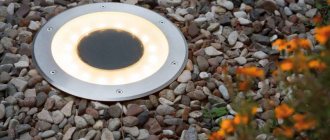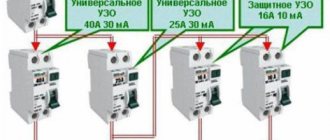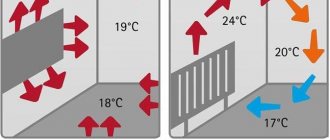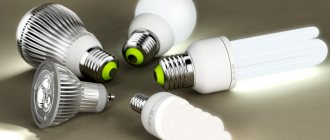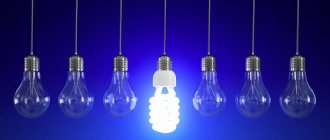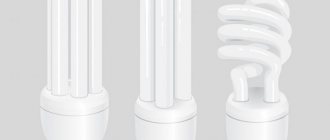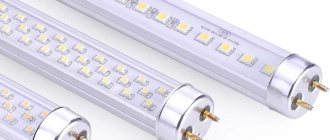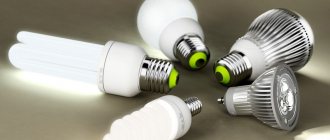The well-being and mood of household members and house guests depends on the quality of lighting. In office premises, lighting parameters affect the performance and fatigue of employees. Fluorescent lamps are one of the most common light sources for household and office lamps. In the article we will look at their principle of operation, advantages, main varieties, labeling and parameters by which energy-saving light bulbs should be selected to create high-quality lighting.
What it is
An internal combustion engine lamp is a light source in which, as a result of the passage of a discharge in mercury vapor, ultraviolet radiation is generated. Using a phosphor (calcium halophosphate compound), the radiation is converted into visible light.
The efficiency of fluorescent lamps is several times higher than that of incandescent lamps. The service life of these lamps is approximately 5 years.
LDS lamp
Important! For maximum service life, the number of starts should be no more than 2000 times, that is, no more than 5 times a day during the two-year warranty period.
Advantages and disadvantages
Fluorescent light sources have the following advantages over halogen and incandescent lamps:
- High efficiency.
- Excellent light output, allowing you to create quite bright light with low power.
- Lighting quality (diffused light). Again, energy consumption is lower compared to incandescent lamps
- Long-term operation (on average 6000-9000 hours), the service life of such lamps can be increased several times (up to 20,000 hours) if ideal operating conditions are maintained.
A mercury-containing light source has one main drawback - the presence of harmful substances in the gas filling. The mercury content in the bulb of a linear lighting element can reach 1 gram per unit of production. Since the dimensions are quite large and the glass of the lamps is very thin, caution should be exercised when using this type of lighting. Fluorescent lamps also have some other less significant disadvantages:
- The operating temperature range is narrow, since this type of lighting elements is characterized by reduced operating efficiency in cold conditions, and at subzero temperatures such lamps may stop working altogether
- Flashing during operation due to design features (the use of special devices called electronic ballasts will help solve this problem).
- After some time, the emitted light deteriorates due to the thinning of the phosphor layer during operation and the resulting change in color temperature.
Important! Despite a significant number of problems with such lighting elements, they are used quite widely due to their high efficiency in comparison with analogues.
Scope of application and advantages of fluorescent lamps
The even, close to natural, diffused light of fluorescent lamps is optimally suited as the main lighting for residential, office and industrial premises for various purposes. They are installed in:
- apartments, elevators and staircases;
- classrooms and school classrooms;
- public and medical institutions;
- shopping, sports and concert and entertainment complexes.
They are used to illuminate lightboxes and other luminous advertising panels.
This popularity of fluorescent lamps is explained by their advantages over incandescent lamps:
- efficiency - with the same light output, they consume several times less electricity, the efficiency of these lamps reaches 80%, while for widely used incandescent lamps it does not exceed 12%;
- durability;
- less heat generation;
- ability to choose the shade of the glow.
With the same power consumption, fluorescent lamps can shine five times brighter and last 12-20 times longer than conventional incandescent lamps.
They are used in table, wall and pendant lamps of various designs and designs.
Principle of operation
The operating principle of such a device is as follows:
- At the beginning, both electrodes included in the design are in the open position.
- When connected to the mains, a glow discharge occurs inside the device, the strength of which varies between 20 and 50 mA.
- The resulting discharge acts on the bimetallic electrode and causes its gradual heating.
- The heated material causes the actuator electrode to bend. Because of this, the glow discharge disappears, which then helps to close the circuit.
- The current begins to move in a closed circuit, which helps heat the inductor and cathodes of the fluorescent lamp.
- Due to the disappearance of the glow discharge, the bimetallic electrode begins to gradually cool after a certain period of time. As a result of these changes, the electrodes move apart, which leads to an open circuit.
- This action helps generate a fast high voltage pulse that acts on the inductor.
- The choke has a high degree of inductance, so this process contributes to the ignition of the lamp.
- The illumination of the lamp gradually increases, and it begins to consume more voltage from the power source.
- The starter is connected in parallel with the lamp, so the starter begins to lack energy and therefore can generate a new glow discharge. Therefore, the electrodes then remain open.
You may be interested in this Features of smart light bulbs
Operating principle of LDS
Basic faults
Malfunctions of fluorescent lamps
The main reasons why fluorescent fluorescent lamps fail include:
- Wear of tungsten filament. Electrodes are made from tungsten filament, which is coated with an active mass. Over time, the coating deteriorates and crumbles, causing the thread to fail.
- Constant activation of the starter in light bulbs with electronic ballasts. It is directly related to electrode burnout. When the starters are constantly activated, the lamp begins to flash, which negatively affects human health.
- Throttle fault. If the inductor breaks, the electric current in the circuit increases significantly, causing the electrodes to heat up sharply. When exposed to high temperatures, the electrodes are destroyed and the lamp stops working.
- Poor quality protection in lamps with electronic ballasts. In devices with electronic ballast, an automatic shutdown circuit is installed when the lamp burns out. In cheap devices from an unknown manufacturer, the protection may be of poor quality or absent altogether. This leads to an increase in voltage and burnout of the ballast transistors.
- Incorrect capacitor selection. If the capacitor does not match the power of the lamp, breakdown will occur.
If the lamp breaks, it is difficult to repair it yourself. It is recommended to contact a specialist or purchase a new device.
Characteristics
Evaluation of the effectiveness of this type of lighting element is based on the compliance of its parameters with the planned operating conditions. Fluorescent lamps have the following characteristics that you should pay attention to when purchasing:
- Product designation. Daylight is defined by the letter D.
- Diameter of the flask. This parameter affects the working time: the higher the value, the longer the useful life of the product.
- The power value by which you can determine the ability of the lamp to illuminate the desired area. Compared to incandescent lamps, the product in question can save up to 80% energy due to the low power level for the same amount of light emitted.
- Type of base. In linear variations, the G13 type is usually used.
- Supply voltage. Differentiated fluorescent lamps are designed for 220 or 127 V.
- Flask shape.
- Colorful temperature. Depending on the model, the temperature of the lighting components can exceed 5000 K.
- Color rendering index - shows the quality of lighting.
- Tube diameter.
- Luminous flux of the product.
Advantages
Production technologies are constantly being improved. Modern energy-saving fluorescent lamps use increasingly better luminescent layers. This made it possible to reduce their power, while simultaneously increasing the efficiency of the light flux, and also the diameter of the glass tube decreased by 1.6 times, which also affected its weight.
Let's consider the advantages of fluorescent lamps:
- high efficiency, savings, long service life;
- variety of color shades;
- wide spectral range;
- availability of colored and special flasks;
- large coverage area.
They consume 5–7 times less electricity than ordinary incandescent lamps. For example, a 20 W fluorescent lamp will give as much light as a 100 W incandescent lamp. In addition, they have a very long service life. In this regard, only an LED light bulb can compare with them and exceed these readings, but it has its own characteristics. They also make it possible to select bulbs that will provide the desired level of illumination. And its variety of color shades will make it easy to decorate the room.
Fluorescent lamps are used in medicine, being used as good lamps and as ultraviolet and bacterial devices. This capability is widely used in the food industry.
It is also very important that such a lamp can illuminate a fairly large area, so it has become indispensable for large rooms. Its minimum service life is 4800 hours, the technical specifications above indicate 12 thousand hours - this is the average value, the maximum is 20,000 hours, but it depends on the number of switches on and off, so it will last less in public places.
Flaws
Despite such great advantages of fluorescent lamps, they can be harmful to health, so such lamps are not recommended for installation at home or outdoors. If such a device breaks, it can poison the room, area and air over a long distance. The reason for this is mercury. That is why used flasks must be submitted for recycling.
Another disadvantage of fluorescent bulbs is their flickering, which is easily caused by the slightest malfunction. It can negatively affect vision and cause headaches. Therefore, it is necessary to ensure that the malfunction is resolved in a timely manner or replace the tube with a new one.
To start the lamp you need a choke, which complicates the design and affects the price.
Prices
36 W fluorescent lamps are economical, provide high-quality bright color and create a pleasant working atmosphere, their prices are low and start from 60 rubles. When choosing them, buyers pay more attention to the need for room lighting. The lamps for them are also very cheap, so when buying a lamp, they pay more attention to the required quality rather than to the price.
Lamps are supplied in boxes of 25 pieces - this is the minimum quantity. You can buy one or more in retail stores, where they are packaged in original boxes. A unit of goods weighs only 0.17 kg. The flask is very light, long and fragile, so care must be taken when transporting it.
What does a fluorescent lamp consist of?
Main structural elements:
- Flask.
- Electrodes are located inside the flask.
- One or two sockets depending on the design of the luminaire and the control device. The last of these elements may be inline or removed.
- Electronic starters are a new solution with certain advantages. However, modern linear light sources are mostly equipped with remote electromagnetic ballasts.
- The starting control device includes a throttle and a starter. The task of the first element is to limit the current to the required value, and the starter is responsible for quickly heating the electrodes, thereby speeding up the reaction of the lamp.
Lamp device
Kinds
Lamps differ in several factors: the shape of the bulb and the pressure inside. Each option has its own areas of application and design features.
High and low pressure lamps
Based on the pressure inside the bulb, light bulbs are divided into two types:
- High pressure. Mainly used outdoors.
- Low pressure. Used in residential buildings and various institutions.
Linear light bulbs
A linear fluorescent lamp is a glass tube with legs containing electrodes welded to the ends. A layer of phosphor is applied to the inner surface.
You might be interested in: Features of connecting IZU for DNAT
Round lamps
They are a type of linear lamps. They have a closed ring shape.
Round LDS
Tubular
The most common variation is with a straight tube design.
Tubular light bulb
U-shaped lamp
Curved lamp design. It is most often used in various lamps.
U-shaped lamp
Application area
Fluorescent lamps in the school classroom
Fluorescent lamps have become widespread due to their advantages. They are used for lighting in houses and apartments, offices, factories and warehouses, in street lighting and illuminated advertising.
Depending on the color rendering spectrum, lamps are:
- similar to solar radiation - used in lighting offices, production workshops, and administrative organizations;
- with increased color rendering - suitable for exhibitions, galleries, museums, hospitals, organizations selling dyes, fabrics and other artistic devices;
- with increased radiation in the red and blue spectrum - used for illumination of aquariums, greenhouses, plant stores, greenhouses;
- with a shift to the blue and UV part of the spectrum - decorating aquariums;
- light in the UV spectrum – solarium;
- High power UV radiation – antibacterial lamps.
Before the active use of LEDs, fluorescent light bulbs were used to backlight LCD monitors. Powerful luminescent devices are used in street lighting of highways, stadiums, and playgrounds.
Device
The device itself is a small gas-discharge lamp that uses the glow discharge principle during operation. Consists of the following components:
- The flask is most often made of glass, which contains an inert gas inside. In modern versions, it can be helium or a mixture of hydrogen and helium.
- The flask is placed in a protective outer casing. It is made of metal or durable plastic.
- The top cover can be equipped with an inspection window if the design allows.
- The starter is equipped with two bimetallic electrodes; their design may differ for different models.
- In addition, the design always contains a capacitor, which not only smoothes out the current at the moment of contact of the closing and breaking device, but also suppresses the arc formed between the contacts. If there is no capacitor, there is a risk of welding the electrode to the arc, which significantly reduces the life of the starter.
Connecting the device
Lamp marking
The markings are designed in such a way that customers can easily select the required lighting element. The most common designations according to Russian standards:
- LB (white light);
- LD (daylight);
- LHB (cool white light);
- LTB (warm white light);
- LE (natural light);
- LHE (naturally cold).
The visible shade directly depends on the color temperature. The color temperature of LDS is 6400-6500K, which is approximately the color of white light.
In addition to the type of lamp, the necessary technical characteristics of the lamp are also indicated: voltage, shape, size, etc.
The three-digit code on the lamp packaging usually contains information about the quality of the light (color rendering index and color temperature).
The first number is the color rendering index 1×10 Ra (a compact fluorescent lamp has 60-98 Ra, so the higher the index, the more reliable the color rendering).
The second and third numbers indicate the color temperature of the lamp.
Therefore, the “827” label indicates a color rendering index of 80 Ra and a color temperature of 2700 K (corresponding to the color temperature of an incandescent lamp).
In addition, the color rendering index can be specified according to DIN 5035, where the color rendering range of 20-100 Ra is divided into 6 parts - from 4 to 1 A.
You might be interested in this Features of a chandelier with remote control
Relationship between degrees and color
Color rendering codes according to the international system:
| Code | Peculiarities | Application |
| 530 | Light of warm tones with poor color rendering. Objects appear brownish and have low contrast. Mediocre light output. | Garages, kitchens. Lately it has become less and less common. |
| 640/740 | “Cool” light with mediocre color rendering and light output. | Very common, should be replaced by 840. |
| 765 | Bluish “daylight” light with mediocre color rendering and light output. | It is found in office premises and for illuminating advertising structures. |
| 827 | Similar to incandescent light with good color rendering and light output. | Housing. |
| 830 | Similar to the light of a halogen lamp with good color rendering and light output. | Housing. |
| 840 | White light for work surfaces with very good color rendering and luminous efficiency. | Public areas, offices, bathrooms, kitchens. External lighting. |
| 865 | “Day” light with good color rendering and mediocre light output. | Public places, offices. External lighting. |
| 880 | "Day" light with good color rendering. | External lighting. |
| 930 | “Warm” light with excellent color rendering and poor light output. | Living spaces |
| 940 | “Cool” light with excellent color reproduction and satisfactory light output. | exhibition halls, museums. |
| 954, 965 | “Day” light with a continuous spectrum of color rendering and mediocre light output. | lighting for aquariums, exhibition halls, |
The principle of Russian labeling
Basic range of color temperatures
The color of the glow is one of the most important parameters, directly dependent on the composition of the phosphor that converts ultraviolet radiation into light.
Today, the most common are 7 definitions of the shades of flux produced by fluorescent lamps:
- LEB – natural white with a noticeable cool tint;
- LDC – natural daylight with improved color rendering quality;
- LTB – warm white;
- LD – traditional day white;
- LB – classic white;
- LEC – natural with the highest quality rendition of shades;
- LCB – simple cool white.
For living spaces where people spend a lot of time, warm shades or natural daylight lamps with a high level of color rendering are suitable.
White and daytime tones are usually present in office, work, industrial spaces, classrooms and classrooms. They promote concentration, increase brain activity and improve overall learning and productivity.
The coolest shades are used in medical institutions, laboratories, hospitals and technical rooms. They give objects additional clarity and enhance visual acuity.
Luminescents for meat displays in grocery stores are distinguished by a specially selected pink emission spectrum. It emphasizes the natural shades of products, making them more attractive in the eyes of buyers.
Color components added to the phosphor make it possible to obtain pink, blue, green and other unusual lamp shades.
Such devices are used for design, advertising and commercial purposes. With their help, they create an original glow that is necessary in a specific individual case.
We wrote more information about the color temperature of light, the peculiarities of human color perception and the nuances of choice in the next article.


